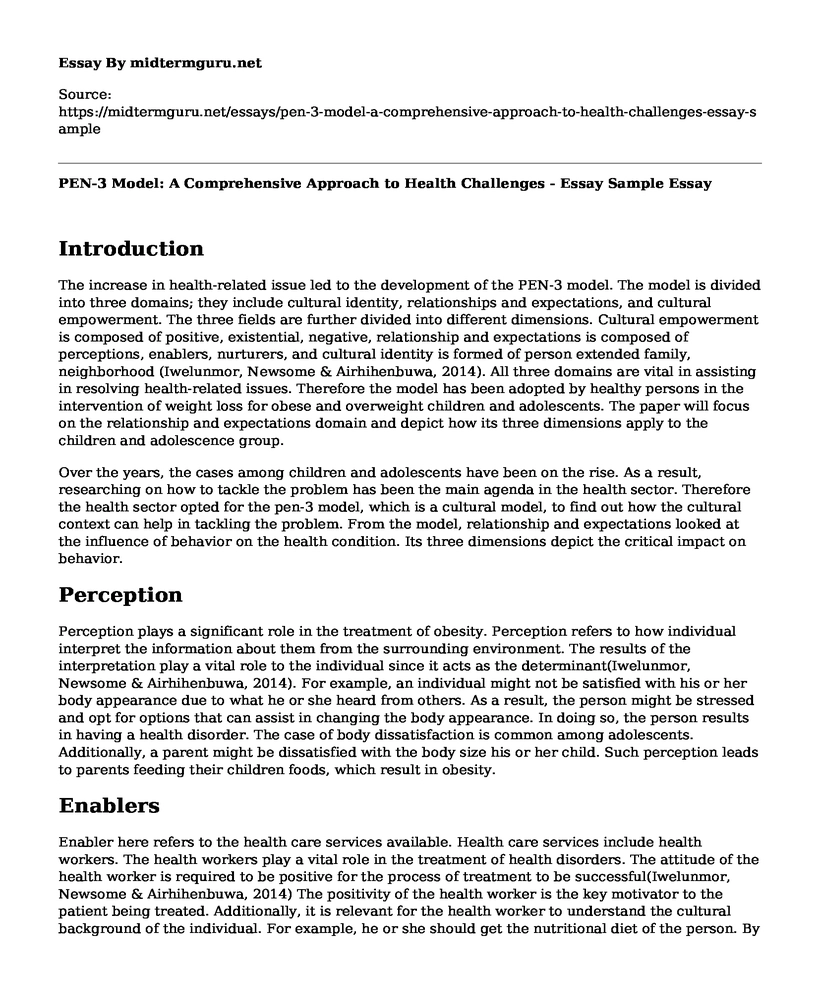Introduction
The increase in health-related issue led to the development of the PEN-3 model. The model is divided into three domains; they include cultural identity, relationships and expectations, and cultural empowerment. The three fields are further divided into different dimensions. Cultural empowerment is composed of positive, existential, negative, relationship and expectations is composed of perceptions, enablers, nurturers, and cultural identity is formed of person extended family, neighborhood (Iwelunmor, Newsome & Airhihenbuwa, 2014). All three domains are vital in assisting in resolving health-related issues. Therefore the model has been adopted by healthy persons in the intervention of weight loss for obese and overweight children and adolescents. The paper will focus on the relationship and expectations domain and depict how its three dimensions apply to the children and adolescence group.
Over the years, the cases among children and adolescents have been on the rise. As a result, researching on how to tackle the problem has been the main agenda in the health sector. Therefore the health sector opted for the pen-3 model, which is a cultural model, to find out how the cultural context can help in tackling the problem. From the model, relationship and expectations looked at the influence of behavior on the health condition. Its three dimensions depict the critical impact on behavior.
Perception
Perception plays a significant role in the treatment of obesity. Perception refers to how individual interpret the information about them from the surrounding environment. The results of the interpretation play a vital role to the individual since it acts as the determinant(Iwelunmor, Newsome & Airhihenbuwa, 2014). For example, an individual might not be satisfied with his or her body appearance due to what he or she heard from others. As a result, the person might be stressed and opt for options that can assist in changing the body appearance. In doing so, the person results in having a health disorder. The case of body dissatisfaction is common among adolescents. Additionally, a parent might be dissatisfied with the body size his or her child. Such perception leads to parents feeding their children foods, which result in obesity.
Enablers
Enabler here refers to the health care services available. Health care services include health workers. The health workers play a vital role in the treatment of health disorders. The attitude of the health worker is required to be positive for the process of treatment to be successful(Iwelunmor, Newsome & Airhihenbuwa, 2014) The positivity of the health worker is the key motivator to the patient being treated. Additionally, it is relevant for the health worker to understand the cultural background of the individual. For example, he or she should get the nutritional diet of the person. By doing so, he or she will be able to know the areas to advise on the condition.
Nurturers
Nurturers are the guardians and relatives of the obese individual. The guardians might be the parents, aunties, or even siblings responsible for the individual. Nurturers play a vital role in the treatment of health conditions. Their practices, such as dietary practices contribute to the successful treatment of obesity and overweight (Lofton, 2019). It is relevant for the guardians to change on their nutritional practices which do not lead to a healthy lifestyle. Additionally, the nurturers should be aware of what is happening to the children, especially those who are at adolescent period. By being involved will help when it comes to advising on the relevant ways to tackle the problem concerning their self-esteem.
Conclusion
Relationship and expectation dimensions play an essential role in the treatment of obesity and weight loss among children and adolescents. The reason as to why it is necessary is due to the fact it addresses the critical contributors to obesity. Body dissatisfaction is a crucial contributor to obesity as a result of one's perception concerning their bodies. Another one is the facilities or people in charge of treating the condition. Their understanding of the background of the individual is what matters for successful results. Lastly, the parents and relatives in charge of the obese child contribute to successive results of the treatment. Their dietary practices and involvement in the lives of their children matter a lot. For the successful treatment of obese and overweight among children, the positive impact from those involved in treatment will be necessary.
Reference
Iwelunmor, J., Newsome, V., & Airhihenbuwa, C. (2014). Framing the impact of culture on health: a systematic review of the PEN-3 cultural model and its application in public health research and interventions. Ethnicity & health, 19(1), 20-46.
Lofton, S., (2019). Using the PEN-3 Model to Explore Cultural Factors that Influence Food Choice for African-American Youth. ABNF Journal, 30(1).
Cite this page
PEN-3 Model: A Comprehensive Approach to Health Challenges - Essay Sample. (2023, Jan 13). Retrieved from https://midtermguru.com/essays/pen-3-model-a-comprehensive-approach-to-health-challenges-essay-sample
If you are the original author of this essay and no longer wish to have it published on the midtermguru.com website, please click below to request its removal:
- Essay on Immunization Among Children
- Therapeutic Relationship in Nursing Practice - Nursing Essay Sample
- Moral and Ethical Issues in Healthcare - Essay Example
- Opera that was dramatic, based on epic stories and loved ones - Opera Seria
- Diversity in Healthcare Personnel: Key to Success - Essay Sample
- Article Analysis Essay on Examine the Connection Between Post Traumatic Stress Disorder
- Nurses Leverage Research to Improve Quality Care - Research Paper







